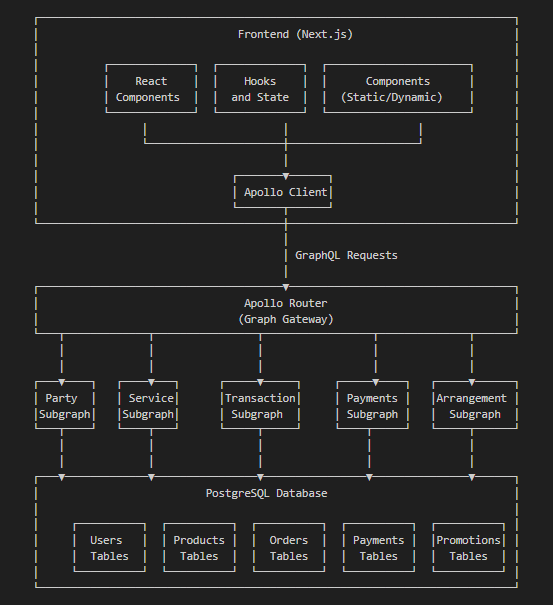In this post, I will outline an e‑commerce platform using GraphQL Federation and Next.js. The goal was not just to spin up another demo shop, it was to explore how these technologies can work together to create a platform that is scalable, maintainable, and ready for real world complexity.
Introduction
E-commerce platforms require robust, scalable architectures that can handle complex business logic while providing excellent user experiences. This project implements a comprehensive solution using GraphQL Federation for the backend and Next.js for the frontend, following domain driven design principles and a clear separation of concerns.
The architecture is designed to be modular and scalable, with separate subgraphs for different domains of the application. This approach allows teams to work independently on different parts of the system while maintaining a cohesive API for the frontend.
Technologies Used
Frontend Technologies
- React: A JavaScript library for building user interfaces with a component based architecture
- Next.js: A React framework that provides server side rendering, static site generation, and the App Router
- App Router: Next.js routing system that enables more flexible and powerful routing patterns
- React Hooks: Functions that let you use state and other React features without writing classes
- State Management: Custom hooks for local state management with local storage synchronization
- Tailwind CSS: A utility first CSS framework for rapidly building custom user interfaces
Backend Technologies
- Apollo Server: A GraphQL server that works with any GraphQL schema
- GraphQL Federation: A specification for building a unified graph from multiple subgraphs
- Supergraph: The composed schema that combines all subgraphs into a single unified API
- Apollo Router: A high performance graph router that implements the GraphQL Federation specification
- Subgraphs: Independent GraphQL services that implement portions of the overall graph
Database and Data Access
- PostgreSQL: A powerful, open source relational database system
- Prisma: A next generation ORM that provides type safe database access
- Repository Pattern: A design pattern that separates the data access logic from business logic
Development and Deployment
- TypeScript: A strongly typed programming language that builds on JavaScript
- Docker: A platform for developing, shipping, and running applications in containers
- pnpm: A fast, disk space efficient package manager for JavaScript
- Domain Driven Design: An approach to software development that focuses on the core domain and domain logic
Additional Technologies
- JWT Authentication: JSON Web Tokens for secure authentication
- Stripe: Payment processing integration
- Vitest: A testing framework for JavaScript
- React Hook Form: A library for flexible and efficient form validation
- Zod: A TypeScript first schema validation library
Architecture Overview
The application follows a modern architecture with clear separation of concerns:

Key Architectural Components
-
Frontend Layer
- Next.js application with App Router
- React components following atomic design principles
- Apollo Client for GraphQL data fetching
- Custom hooks for state management
-
API Gateway Layer
- Apollo Router implementing GraphQL Federation
- Composition of multiple subgraphs into a unified API
- Authentication and authorization middleware
-
Subgraph Layer
- Domain specific GraphQL services
- Independent deployment and scaling
- Clear boundaries between different business domains
-
Data Access Layer
- Repository pattern implementation
- Prisma ORM for type safe database access
- Domain models representing business entities
-
Database Layer
- PostgreSQL database with relational data model
- Separate tables for different domains
- Foreign key relationships between related entities
GitHub Repository
You can find the complete source code for this project on GitHub:
https://github.com/aamersadiq/graphql
Conclusion
This e-commerce platform demonstrates how modern web technologies can be combined to create a scalable, maintainable application. By leveraging GraphQL Federation, Next.js, and domain driven design principles, we’ve built a system that can grow with business needs while maintaining developer productivity and code quality.
